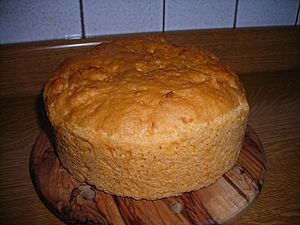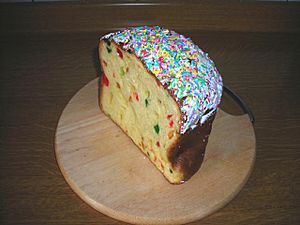Pizza di Pasqua facts for kids

Umbrian Pizza di Pasqua
|
|
| Alternative names | crescia di Pasqua, torta di Pasqua, torta al formaggio, crescia brusca |
|---|---|
| Type | Easter bread |
| Course | main dish |
| Place of origin | Italy |
| Region or state | Marche, Umbria, Lazio, Abruzzo, Molise |
| Associated national cuisine | Italian |
| Created by | nuns of the monastery of Santa Maria Maddalena at Serra de' Conti, Ancona |
| Serving temperature | room temperature |
| Main ingredients | wheat flour, pecorino, parmigiano, eggs, olive oil or lard, natural yeast, milk |
| Variations | baker's yeast, emmentaler |
The Pizza di Pasqua (which means "Easter Pizza" in English) is a special savory cake from central Italy. It's also known by other names like crescia di Pasqua or torta al formaggio. This tasty cake is made with wheat flour, eggs, and two types of cheese: pecorino and parmesan.
People traditionally eat Pizza di Pasqua for breakfast on Easter morning. It's often served with blessed boiled eggs, a type of sausage called ciauscolo, and red wine. You might also see it as an appetizer during Easter lunch or enjoyed at a picnic on Easter Monday. It looks a bit like a panettone (another famous Italian cake). This special bread is very popular in the Marche and Umbria regions of Italy. There's even a sweet version of it!
Contents
What's in a Name?
The word pizza in "Pizza di Pasqua" doesn't mean the flat, round pizza we usually think of today. Long ago, in the Middle Ages, the word piza meant a type of 'focaccia' or flatbread. This tells us that Pizza di Pasqua is a very old dish. The term piza was first used in old documents in Italy around the year 966. It was often used for special foods baked for celebrations like Easter.
Where Did It Come From?
Tradition says that the Pizza di Pasqua was first made by nuns in the Middle Ages. They lived in the Poor Clares monastery of Santa Maria Maddalena in a town called Serra de' Conti, near Ancona.
The name crescia, which is used in the Marche region, comes from the Italian word "crescita," meaning "growth." This refers to how the dough grows and rises during the baking process. The first written mention of this special bread was in a cookbook from the nuns in 1848. It was called Memorie delle cresce di Pasqua fatte nel 1848 ("Memories of the crescie di Pasqua made in 1848").
How It's Made Through Time
Old Recipes
Old recipe books from the 1800s describe how to make Pizza di Pasqua. One recipe for three cakes called for a lot of ingredients! It used 16 pounds of flour, 40 eggs, and different kinds of cheese. The 40 eggs in this recipe were meant to remind people of the 40 days of Lent (a period of fasting before Easter).
Another old recipe from 1848 suggested using 50 pounds of flour and 10 pounds of grated old cheese. These old recipes show how important this bread was for big Easter celebrations.
Modern Recipes
Today, the main ingredients for Pizza di Pasqua are wheat flour, eggs, and grated pecorino and parmesan cheeses. It also includes extra-virgin olive oil, salt, pepper, natural yeast, and milk. Some recipes might add saffron for color and flavor. Sometimes, lard or butter is used instead of oil, or emmental cheese instead of pecorino.
The dough needs to be mixed for a long time. This helps it become stretchy and rise well. Then, the dough is put into special molds. These molds are often flared, like the shape of a panettone. The dough then rests and rises for a long time. Traditionally, it was baked in a wood-fired oven. In the past, people would take their dough to a local bakery to be cooked.
Easter Traditions
According to religious tradition, Pizza di Pasqua should be prepared on Maundy Thursday or Good Friday. This is so it can be eaten on Easter Sunday, after the period of fasting during Lent.
Before modern heating, people would warm their beds with a special tool called il prete ("the priest"). This tool held hot embers from the fireplace. They would then place the dough in the warm bed to help it rise. Once the cakes were ready, it was common to take them to church. There, they would be blessed along with other foods for the Easter meal.
Sweet Version
In the Umbria and Marche regions, you can also find a sweet version of Pizza di Pasqua. This sweet cake doesn't have cheese. It might have candied fruits mixed in. The sweet version often has a fiocca on top. A fiocca is a meringue glazed with sugar beads, making it extra special.
Images for kids
See also
 In Spanish: Pizza de Pascua para niños
In Spanish: Pizza de Pascua para niños




